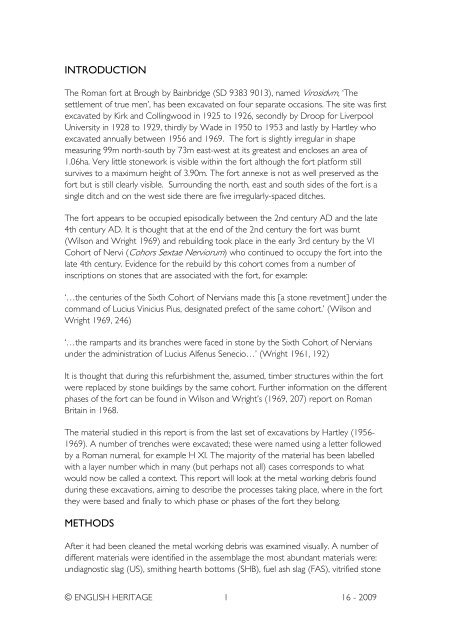THE ROMAN FORT AT BROUGH, BAINBRIDGE ... - English Heritage
THE ROMAN FORT AT BROUGH, BAINBRIDGE ... - English Heritage
THE ROMAN FORT AT BROUGH, BAINBRIDGE ... - English Heritage
Create successful ePaper yourself
Turn your PDF publications into a flip-book with our unique Google optimized e-Paper software.
INTRODUCTION<br />
The Roman fort at Brough by Bainbridge (SD 9383 9013), named Virosidvm, ‘The<br />
settlement of true men’, has been excavated on four separate occasions. The site was first<br />
excavated by Kirk and Collingwood in 1925 to 1926, secondly by Droop for Liverpool<br />
University in 1928 to 1929, thirdly by Wade in 1950 to 1953 and lastly by Hartley who<br />
excavated annually between 1956 and 1969. The fort is slightly irregular in shape<br />
measuring 99m north-south by 73m east-west at its greatest and encloses an area of<br />
1.06ha. Very little stonework is visible within the fort although the fort platform still<br />
survives to a maximum height of 3.90m. The fort annexe is not as well preserved as the<br />
fort but is still clearly visible. Surrounding the north, east and south sides of the fort is a<br />
single ditch and on the west side there are five irregularly-spaced ditches.<br />
The fort appears to be occupied episodically between the 2nd century AD and the late<br />
4th century AD. It is thought that at the end of the 2nd century the fort was burnt<br />
(Wilson and Wright 1969) and rebuilding took place in the early 3rd century by the VI<br />
Cohort of Nervi (Cohors Sextae Nerviorum) who continued to occupy the fort into the<br />
late 4th century. Evidence for the rebuild by this cohort comes from a number of<br />
inscriptions on stones that are associated with the fort, for example:<br />
‘…the centuries of the Sixth Cohort of Nervians made this [a stone revetment] under the<br />
command of Lucius Vinicius Pius, designated prefect of the same cohort.’ (Wilson and<br />
Wright 1969, 246)<br />
‘…the ramparts and its branches were faced in stone by the Sixth Cohort of Nervians<br />
under the administration of Lucius Alfenus Senecio…’ (Wright 1961, 192)<br />
It is thought that during this refurbishment the, assumed, timber structures within the fort<br />
were replaced by stone buildings by the same cohort. Further information on the different<br />
phases of the fort can be found in Wilson and Wright’s (1969, 207) report on Roman<br />
Britain in 1968.<br />
The material studied in this report is from the last set of excavations by Hartley (1956-<br />
1969). A number of trenches were excavated; these were named using a letter followed<br />
by a Roman numeral, for example H XI. The majority of the material has been labelled<br />
with a layer number which in many (but perhaps not all) cases corresponds to what<br />
would now be called a context. This report will look at the metal working debris found<br />
during these excavations, aiming to describe the processes taking place, where in the fort<br />
they were based and finally to which phase or phases of the fort they belong.<br />
METHODS<br />
After it had been cleaned the metal working debris was examined visually. A number of<br />
different materials were identified in the assemblage the most abundant materials were:<br />
undiagnostic slag (US), smithing hearth bottoms (SHB), fuel ash slag (FAS), vitrified stone<br />
© ENGLISH HERITAGE 1<br />
16 - 2009

















